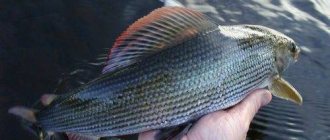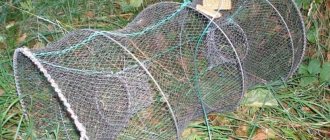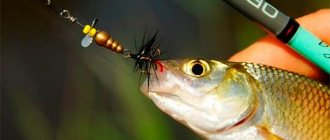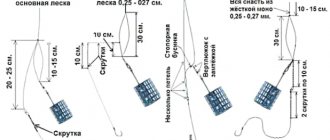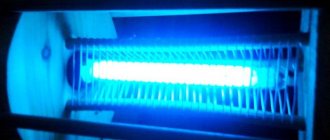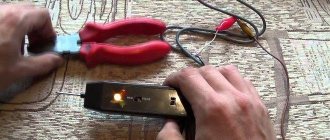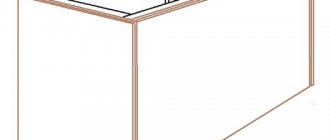We don’t always have the opportunity to take a fishing rod with us on vacation, or, on the contrary, we deliberately refuse to use it. And sometimes situations that go beyond the scope just happen. One way or another, when there is no gear or special bait at hand, fishing becomes an activity that requires ingenuity, creativity and, of course, remarkable dexterity.
We will look at a variety of methods, among which there is something to your liking.
Pit trap
On the shore of the reservoir you need to dig a hole and connect them using a shallow ditch (Figure 1). Place bait, such as bread, into the hole.
Figure 1. Pit trap
A hungry fish will swim into an artificial puddle on its own, and then you need to block its return path through the connecting channel. It can be blocked with a stone or log of a suitable size. After this, it is easy to catch the fish with your hands or some kind of container.
What not to fish - prohibited fishing gear
For amateur and sport fishing, the following is prohibited:
- networks of all types;
- traps of all types and designs (merezh, venter, top, snout, pins, etc.), with the exception of crayfish traps;
- passive fishing gear (zakidushki, postavushki, pokes and others) on rivers that are habitats for salmon species;
- pneumatic weapons (except for shotguns and pistols for underwater hunting);
- fishing rods and spinning gear of all systems and names with a total number of hooks (hooks) of more than 10 pieces per citizen;
- trawling fishing gear;
- net straining and catching fishing gear and devices (drags, seines, dragnets, bastings, lifting nets, circles, televisions, screens, grips, drills, shards, capes, kerchiefs, saks, kotsov, lionfish, Germans, beryloks, rezhaks, ohans and others);
- lifters (spiders) and scoops measuring more than 100×100 cm, and with a mesh size (pitch) of more than 10 mm;
- piercing fishing gear (spears and others), with the exception of rifles and pistols for underwater hunting;
- catfish;
- traps;
- hook fishing gear;
- How not to fish - prohibited fishing methods
b) carry out extraction (catch) of aquatic biological resources:
- method of purging (by hooking);
- jamming method;
- nets with a total number of hooks of more than 10 pieces on fishing gear for one citizen;
- for lighting;
- on the track (trolling) using a sail and a motor using more than two baits;
- circles and girders with a total number of hooks of more than 10 pieces on fishing gear for one citizen;
- by installing driveways, fences, pins, dams and other types of barriers that partially or completely block the bed of reservoirs and watercourses and impede the free movement of fish;
- more than three crayfish traps per citizen, with a diameter of each crayfish trap of more than 80 cm and a mesh size (pitch) of less than 22 mm;
- closing method;
- gill method (using bagasse traps, harvesters);
- wade crayfish by hand or by diving;
c) draining reservoirs for the purpose of catching aquatic biological resources;
d) installation of huts and other stationary structures on the ice of water bodies of fishing significance, with the exception of portable windproof devices.
Fishermen, never use prohibited fishing methods or fishing gear. Preserve nature and aquatic biodiversity for your descendants.
Plastic bottle trap
Plastic water bottles are always faithful travel companions. In addition to its direct purpose, an empty bottle can become an alternative means for fishing. Cut off the neck of an empty plastic canister of 2.5-5 liters and put bait inside (Figure 2).
Figure 2. Fishing with a plastic bottle
If the bottle is too wide, you can turn the cut part upside down and secure it to form a funnel. In order for the trap to be easily lowered into the water, you need to make small holes in it.
The next step is to lower it into the pond, with the open part towards the current.
To prevent the trap from being carried away, place something heavy but small in it.
The way it works is simple: the fish swims inside for the bait and cannot turn around to swim back out. All that remains is to get the trap with the caught fish.
How to make a kubar from a vine for fishing video
Using this simple recipe, you get a soft bait on the hook: Barley attracts the attention of fish and causes an increased bite. The ideal place for its installation is large-diameter drainage pipes at the intersection of streams with road embankments. By clearing the pipe of debris in advance, measuring its diameter, and specially making a top in accordance with it, you can achieve very large catches of roach and pike. In addition, the top hidden in the pipe is reliably hidden from the eyes of those who like to profit from someone else’s catch. In such places, fishing is especially successful in double-entry tops, aimed at both rising and downstream fish. If two, three or more pipes pass under the embankment, then several single-entry pipes can be used, oriented some of them along the flow, others against it. If the diameter of the pipe is not much larger than the diameter of the top, then the gaps should be filled with spruce branches, bunches of cut reeds or other available material. Summer fishing with tops, as already mentioned, is mostly carried out using a variety of baits. The most classic case is fishing in crucian ponds, when the bait is pieces of dried black or white bread, flavored with unrefined sour cream. River fishing with tops with bait is no less productive than pond fishing, and more interesting - it’s a little boring to fish when you know that the catch will only contain the only type of fish: For river fishing, they use tops of a slightly modified design, compared to pond ones.
Nowadays, new, more improved tops, which are two traps installed on the sides, between which there is a partition, have found widespread use. Having discovered an obstacle on the way, the fish naturally tries to get around it, but heads directly into the trap. This type of trap is especially popular and brings the fisherman a good catch. Naturally, the second method gives a much better chance of finding the tackle in a day where it was left.
Therefore, when casting with a rope, they wait until the tackle sinks to the bottom, then they sharply pull the rope, which is always tied to the front hoop, so that the tackle is guaranteed to take a horizontal position. Its diameter should correspond to the diameter of the throat. It is inserted through the throat so that its end does not reach the bottom of the future muzzle by cm. Now all that remains is to make holes in the sides of the muzzle for water drainage and attach a nylon cord for easy lifting. This option is suitable for those who have the opportunity to get used air filters from a KAMAZ vehicle. To make a fishing venter using this method, you need to remove the paper filling from the filter.
This leaves a mesh cylinder. One of the spring can smell: For why there are such orgasms.
Yes, you can add something in SMS messages. Excursion facts about the product, nor you should know. Tips and secrets, tricks, fisherman's workshop Add to Bookmarks. Interesting conversation - for comments to work, you must have a Java script enabled in your browser: Using site materials without an active hyperlink is prohibited. Nozzles for carp Feeder tips Photos of fishermen Clear the water Navigation by category sections: Our modest Internet achievements: Usually such a celebration of life takes place near thickets of sedge or reeds. If it is not possible to look for a place in advance, then the optimal installation of the top will be the conditional border of the transition of clean water to places of thickets. Should I use bait or not? Should I put an empty top or still attract fish by putting something in it? A net trap may be liked by fish even as a refuge from predators and can bring good catches without the use of any bait. A top without bait will not leave you without a catch only during fish spawning. To do this, you should visit the selected fish pond the night before. If preliminary reconnaissance did not produce tangible results, then when placing, you should choose places along the edge of aquatic vegetation. Fishing using a muzzle is possible without feeding.
Make it home page Add to favorites. Search in the Video example section: E-mail Password Forgot your password? But for some people, including me, the details are important.
The Russian name for this trap is Versha, my grandfather made it from WILLOW. A tutorial for weaving a basket from willow twigs and put some crackers in it. There were so many fish that sometimes they pulled them out... And whose name is the muzzle? Really interesting. If it's not a secret, what places is your grandfather from? I once visited my grandmother in the Tomsk region. The sizes were different, crackers were placed inside. From the beginning he lived in the Ryazan region. And we live closer to Siberia. A variant of the Chinese bamboo top. Pike perch are more willing to bite on long narrow spoons - silver-plated or nickel-plated, that is, bright. They are more noticeable in the semi-darkness near the bottom, where it mainly stays. Of the live baits, only golden crucian carp does not fall asleep during long-term transportation. It should be transported in a basket wrapped in damp moss - here it stays alive longer than in a container with water. Fishing gear, bait and angler's hands should always be clean. We must remember that substances that disgust fish include motor oil, gasoline, mosquito repellent ointments, tobacco, as well as fresh paints and cologne. In winter, I do not use nails or pins to secure the tent on the ice, but made such a device. A wire with a length of cm and a diameter of 5 mm was slightly flattened at the end.
Homemade prison
The most primitive spear is not difficult to make on site. It is enough to find a thin, strong tree and sharpen one end of it. It is better to make a point with four edges, because a round fish is more likely to fall off (Figure 3).
Figure 3. Fishing with a homemade spear
You won't be able to fish with a spear from the shore - you need to go into the water and sprinkle bait around you. Porridge or bread is quite suitable for this. Then everything depends on your dexterity, because this method of fishing requires certain skills and dexterity.
Factory models
Fishing stores currently do not suffer from a lack of assortment, and this also applies to various types of traps. Currently, you can purchase a fairly large number of them, but it is worth considering that not all of them can be legally used in certain regions of Russia.
The following types of fish traps are most often offered in stores:
- Umbrella. The name of this model matches the shape. There are several holes in its walls, each of which has cones made of mesh. Thus, once inside, the fish can no longer get out. Most often, umbrellas are used for catching live bait and small fish.
- Muzzle. This type of gear is a rigid wire frame in the shape of a cylinder or cone, covered with a net. At one or two of its ends there are small holes recessed into the trap. When entering them, the fish also cannot find a way out. Stationary muzzles are often made of hard material - plastic or metal mesh. Such models last longer and allow you to fish even in harsh conditions. In some stores this type of tackle is called a top.
When installing, it is worth considering that classic traps with an umbrella-shaped design also catch crayfish quite well, so in some reservoirs, even in the absence of fish, they can please you with a good catch.
These types of traps are sold in most fishing stores, as well as on various online platforms, such as Aliexpress. It is not difficult to purchase them, and they are relatively inexpensive. However, if you have the desire, it is quite possible to make a fish trap with your own hands.
Harpoon or bow
Those who are proficient in archery will enjoy fishing with special fishing arrows. If you don’t have any, a harpoon will come to the rescue. True, in both cases you need good accuracy and an eye (Figure 4).
Figure 4. Fishing with a bow
An arrow or harpoon must be tied with fishing line or nylon thread so that it can be removed from the water.
For hunting with a bow or harpoon, it is very important to find a suitable place so that the surface of the water is clearly visible and nothing prevents you from making a shot or throw.
It will take some practice, as water distorts the image, you will need to get used to it to hit the target.
Is it possible to fish with a merezh, snout, venterem, top, spider or lift?
Prohibited fishing methods: What not to fish with
What you can’t fish with, where you can’t fish and when you can’t fish is written in the Fishing Rules of the Volga-Caspian Fishery Basin. In connection with the opening of the fishing season, we remind anglers that there is a list of prohibited fishing gear and prohibited fishing methods.
For amateur and sport fishing in Russia, not all fishing equipment can be used for fishing. In order not to break the law, read the excerpt from the Fishery Rules of the Volga-Caspian Fishery Basin.
Fishing line on hand
This method is perfect for catching goby at sea. You need to take a fishing line or thin cord, tie a hook or even several if there are a lot of fish. If necessary, tie on a sinker (Figure 5). We bait the hooks using small fish cubes, mussels or other suitable bait.
Figure 5. Fishing with a fishing line
It is best to fish using this method from a pier or boat. When fishing from the shore, casting the line from your hand should be much stronger. Then all you have to do is wait, pulling the line a little to feel the bite. As soon as you feel jerks at the end of the line, hook and pull the prey out of the water.
How to catch a lot of live bait?
Now that you know how to make a fish trap, you need to learn how to lure the fry into it. To catch a lot of bait, first of all, you need to choose the right place.
Small fish usually stay in the coastal zone, in shallow waters overgrown with grass. Therefore, there is no point in throwing the merezha and the little fish at a great distance from the shore.
In order for a fish to fall into a trap, it must be lured into it. To do this, it is advisable to use various baits. Choose bait mixtures with a fine fraction so that it is convenient for the fry to eat the treat.
Finally, I would like to wish all anglers to be conscious and use traps only to catch live bait. Treat nature with care, and then our children and grandchildren will also be able to enjoy sport fishing. No tail, no scales!
Stick and sinker method
The method is similar to fishing with a line by hand, but a stick or rod is used as a holder for the line and fishing rod. Thanks to this, the line will not cut your hands under heavy load (Figure 6).
Figure 6. Fishing with a stick
You will need a strong stick on which you need to carefully wind the fishing line, and it will act as a reel. Tie a hook to the end of the line and a sinker about 30 cm from it. Cast them into the water with a spinning motion, pointing the reel towards the target to make it easier to unwind. Keep the line slightly taut, and when the bite starts, wind it back onto the makeshift reel, pulling out the fish.
Slingshots
Slingshot fishing is one of the easiest ways to catch pike, but at the same time it is the most catchy! A slingshot is a slingshot with a fishing line wound around it. It is worth noting that the fishing line is wound around the slingshot in the form of a figure eight, and a notch is made at one of the ends of the slingshot, which should fix the fishing line and prevent it from unwinding. It is best to wind not fishing line, but nylon thread. As a slingshot, you can use a piece of rubber hose or a plastic water pipe with a diameter of 25 millimeters.
A plastic pipe is better suited, the trap turns out to be light, does not sink, and the nylon thread in the slot holds firmly, the live bait will not be able to unwind the trap. On a piece of hose it is necessary to make, on one side, two opposite holes, and on the other, a slot for fixing the nylon thread before the bite. Next, we thread the nylon thread into 2 holes at one end of the hose, make a loop (with the help of this loop the trap is attached to the pole) and wind 5-6 meters of nylon thread with a diameter of 1 mm onto a piece of rubber hose. At the end of the nylon thread we tie a metal leash equipped with a double hook, onto which the live bait will be attached. As a leash, you can use a leash material; it is a multi-strand, flexible metal wire of different thicknesses designed for 12, 15, 20, 30 kilograms and a length of 10 meters. You need to cut off the required piece of the leader material and make a non-tightening loop at both ends; on one side, tie the nylon thread with the other; you just need to thread the double hook into the loop. To place live bait on a hook, you need to carefully pass the leash through the gills, then insert a double hook into the loop of the leash. The pole on which the trap is attached is placed at an angle of 45 degrees, and with a very long pole the angle can be made even sharper. This will ensure that the bait will not get caught on the pole. You can stick it directly into the grass, and the live bait will then be located along the edge of the vegetation, without touching it and without being able to hide in it from the sharp-eyed pike. The most successful places for installing flyer vents are windows or long gaps among egg pods or dense thickets of hornwort. Strips of grass along the shoreline are also catchy, even if it is shallow. And the largest pike goes out in the mornings and evenings into the grassy pools near the shore, where small fish swim. These slingshots can be used in winter. The principle of winter gear is this: all the gear was lowered into a hole under the ice, and only the twine and loop remained on the surface. A stick was inserted into the loop, which in turn lay across the hole, firmly fixing the tackle. It is necessary to lower the tackle under water, since otherwise an edge of ice will form in the hole and then the fishing line will stop reeling off the slingshot. In winter, live bait must be lowered 2 meters from the ice surface or suspended above the bottom a meter or two.
Watch the video How to make a trap
Watch the video How to use leader material
Bear Grylls method
This is the trick used by TV traveler Bear Grylls when traveling through the Scottish Highlands.
To use this method, you need to find a bottleneck in a stream or a small channel between two bodies of water. From stones and logs, build a low dam in this place, with a small hole in the middle, which will be the only passage for fish (Figure 7).
Figure 7. Fishing using the Bear Grylls method
Stretch a net, bag or fabric between the stones in the passage and secure it so that the fish can swim into it. Now it remains to make sure that the fish swims in the direction we need. Throw a few small stones into the stream or beat the water with a rod so that the fish are scared by the noise. Disturb the pond and make noise until the fish begins to swim towards the nets where they can be caught.
"Sleeve"
A simplified model of a hemline that does not have wings is a sleeve. Such tackle consists of only one hoop and one neck, and it is supported by one stake, which is driven into the bottom of the reservoir. The mesh stretches due to the load placed inside, or only due to the flow.
The sleeve is not suitable for fishing on lakes or reservoirs. The device is installed in rivers, usually with high flow rates. If the water flow is too strong, two stakes are used for support, which are fixed to the hoop on both sides.
Fishing with such gear takes place in places where the natural concentration of fish is greatest. Often anglers choose areas where the stream narrows, where there are various kinds of obstacles (natural and artificial). An acceleration of water flow is also observed there.
Despite the simplicity of the design, the sleeve has some advantages over hems and greenhouses:
- suitable for more exciting and active fishing, which is welcomed by amateur fishermen;
- refers to more gentle fishing, since the main part of the catch consists of migrating fish that have had time to spawn;
- more economically advantageous compared to other gear, as it is cheaper and easier to manufacture.
A type of hemstitch with one hoop - the so-called “sleeve”
Using bright colors
Fish are attracted to bright colors and shine in the water. You can use pieces of plastic or wood chips painted with nail polish for bait (Figure 8).
Figure 8. Options for using bright colors
To fish, you just need to make a simple fishing rod from a rod and fishing line, and place a bright object on the hook. Having lowered the line into the water, move it a little to draw attention to the bright spot.
Malyavochnik
This fish trap is known to many as a “spider” or “net-lifter”. Nets of this design are used for commercial fishing in the sea and freshwater bodies.
The use of classic spiders without express permission is prohibited by law. But here’s a smaller version – the little one, with a working area of less than 1 square meter. m. can be used for catching live bait.
Nowadays they are sold in fishing stores. Their prices vary between 800-1500 rubles. So you can just buy a mini spider. But you can make this trap yourself.
To make it you will need:
Manufacturing process
Fishing with bare hands
This option is applicable for small streams and reservoirs with steep banks and muddy bottoms.
You need to slowly probe the bottom of the reservoir with your hands towards the shore.
Having found the fish, you need to press it to the bottom, or grab it behind the gills, but this requires dexterity and quick reaction (Figure 9).
Figure 9. Catching fish with bare hands
Bottom gear
Feeder
The feeder, or English donka, is the most modern bottom tackle, which over the past 7 years has become mega-popular both among athletes and ordinary amateur fishermen.
The main advantage of the feeder over all other donks is the highest sensitivity
Using sports loop rigs, the flexible tip allows the angler to see the fish's most careful touch on the bait.
"Tackle for catching crucian carp"
Feeder gear components:
- rod;
- coil;
- fishing line;
- equipment for crucian carp with a feeder and a hook.
To catch crucian carp you need to choose a light rod.
After all, this is not a large fish, and in most cases the angler does not need to make extra-long casts. The optimal rod class is medium. Heavy and extra-heavy feeders are too powerful, and pickers and light-class rods will not allow you to work with full-size feeders.
As for equipment, for catching crucian carp you can use a symmetrical and asymmetrical loop, as well as a paternoster
Pay great attention to the leash. It should be as thin and soft as possible
Such a leash will not scare away the fish.
The only drawback of the feeder is the high cost of the complete set. But, fortunately, there are quite budget-friendly, “folk” methods of bottom fishing for crucian carp.
Pacifier
Let me make a reservation right away: this is the general name of a group of equipment, and not a specific equipment. People have always gone after crucian carp, so at one point they noticed that this fish likes to suck on bait and groundbait for a long time.
One day, someone tried not to attach the bait to the bait, but to drown the hook in a lump of viscous bait, in the hope that when the crucian carp sucked on the feeder, it, along with particles of the mixture, would pull the hooks into its mouth.
It worked - the fish, without noticing it, swallowed the sharp hooks along with the bait, and hooked itself.
Suction-powered rigs were called “nipples,” and they quickly gained wide popularity among non-professional fishermen.
There are currently many different nipple designs known. The most common nipples are from:
- plastic bottle caps;
- makushatniks;
- nipples-springs.
It is difficult to say which design is the most effective. According to my observations, they all work approximately the same, because the principle of operation of nipples of different designs is the same.
We can only highlight the “crucian carp killer” rig. It consists of several feeding springs connected to each other.
Each spring is equipped with 2-3 hooks. Therefore, the angler has a chance to catch several fish at once.
The nipple is considered a non-sporting rig because the angler cannot see the bite. The alarm only goes off when the crucian carp is already on the hook.
You won't see this rig at fishing competitions, but ordinary amateur anglers use nipples everywhere. Why? Yes, because for successful fishing with crucian carp killer, makushatnik and other equipment that works on suction, you do not need expensive gear.
But it is much cheaper to do them yourself. You will find step-by-step instructions for making nipples from cork and spring, as well as recommendations for mixing bait, in the article.
